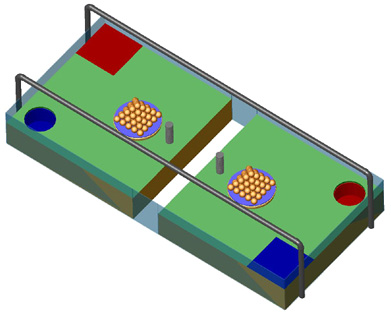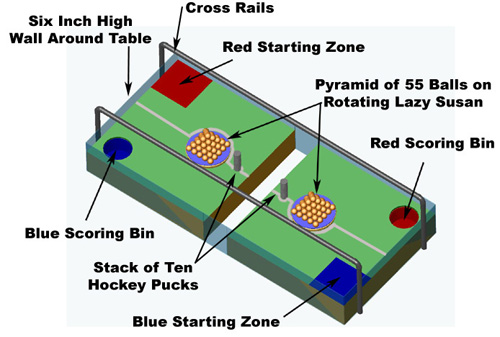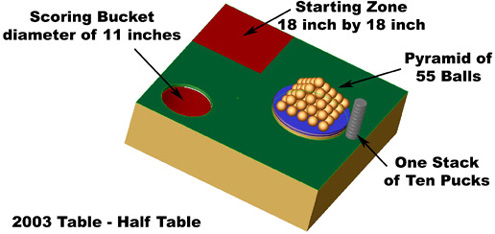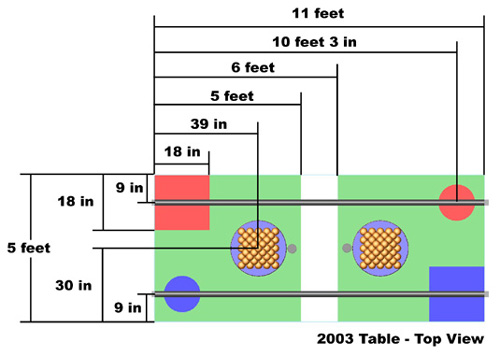All images courtesy of Alex Slocum.

One Robot to Rule them All.....

2003 table overview.
Table Description
The 2003 Table consists of two separate tables surrounded by a clear plastic wall.
Each half of the table contains four important zones:
- Starting Zone - Each robot must begin the competition within this 18 inch by 18 inch square, as well as an additional 2 inch zone that extends beyond the plastic walls. The starting zone extends to 21 inches above the table surface.
- Scoring Zone - The scoring zones consist of a plastic bucket on top of a scale. All mass must be placed in the plastic bucket to receive any mass score. The player who starts in the Blue Starting Zone can increase their score by adding mass to the Blue Scoring Zone. The player who starts in the Red Starting Zone can increase their score by adding mass to the Red Scoring Zone. Either player can add mass to their opponent's scoring zone, but you really wouldn't want to do that. Only balls and pucks may be used as mass on the scales.
- Rotating Platter - The rotating platters contain a pyramid stack of 55 balls. A small rubber O-ring will be placed on the outer rim of the disc. The platters are placed on a "Lazy Susan" syle turntable bearings (see Ball Thrust Bearings at How Bearings Work) to allow them to rotate freely in either direction. An absolute rotary encoder that records the absolute value of the angle rotated is attached to each platter. In other words, the encoders will record the total angular travel regardless of the direction in which the platter is spun and regardless of any changes in the direction of the travel. The pyramid of balls is set into a series of holes through the platter. A stack of pucks is placed halfway between the platter edge and the chasm edge.
- Cross Rails and Side Walls - The only connections between the two tables are a pair of round horizontal bars and the side walls of the table. These PVC bars span the entire length of the table, from behind one starting zone to the corresponding scoring zone. The PVC pipe has a diameter of 2-1/8 inches. The rail area contained within the starting zone is considered part of the starting zone. Contestants may start the contest clamped to the sidewalls and/or the rail.
An important feature not shown in the figure is a one inch dividing line extending the length of the table. This line goes down the center of the table (midway between the two rails) with a small detour around the rotating tables and pucks. During the contest, contestants may not cross the line or deploy any offensive tactics across this line until they have placed weight (a ball or puck) on their own scale. Offensive tactics include barriers and molestabots, as well as engaging, covering, encircling, etc. their opponent's rotating table, pyramid of balls, or puck stack.
On the edge of gap between the tables is a small metal bar.
Note: The stack of pucks will be placed halfway between the edge of the platter and the edge of the chasm.

Labelled table view.
How to Score
There are two ways to score:
Mass (Street hockey balls or hockey pucks) can be placed on the scales. No machines may be placed in the buckets.
The platters may be spun on the lazy susans.
These inputs are used to determine the score using the following equation:
Score = (mass + 100 grams) x (cumulative rotation of platter + 1 radian)
All mass is measured in grams. Platter motion is measured in radians.

Rotating platter close-up view.

Half table close-up view.
Critical Table Dimensions
Note: These dimensions are approximate and may change. The final dimensions are as determined on the physical tables in the Pappalardo Lab. Solid models of the table are available here: both SolidWorks® and Pro/Engineer® (ZIP - 1.8MB) (The ZIP file contains: 10 .sldprt files and 3 .sldasm files.)

Side view of table with measurements.

Top view of table with measurements.
If you want the elvish script in black and white, download this (JPG).
Rules (PDF)
FAQ/Court Decisions (PDF)
